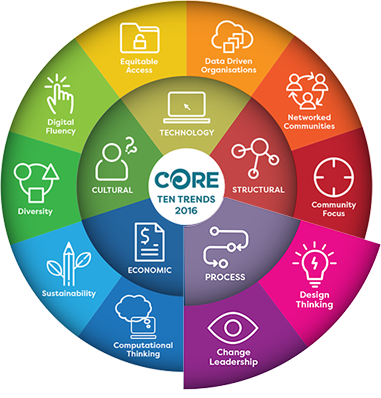Change leadership

As the local and global rates of change continue to increase, organisations are finding themselves required not only to keep pace with these changes but also to anticipate them in order to prepare learners for the future. Change seems to be gathering pace everywhere: changes in the environment, population, demographics and migration; increasing diverse communities, the availability and distribution of resources, increasingly powerful technology which seems to be impacting on just about every aspect of our lives. Education faces a challenge to keep pace with all of these changes, particularly given that many of our traditional leadership practices were designed for a slow-moving world with a small group of people (or even one person) making most of the decisions. The traditional ‘pyramid-style’ hierarchy that existed in most 20th century organisations still holds considerable influence over organisations in the 21st century, however newer and more agile arrangements are required if we are to successfully navigate the future.
Implications and impact
The traditional notion of the clever single leader at the top of an organisation required that person to have at their fingertips all of the information required in order to make decisions. This information might be to do with finances, staffing, market (community) needs, best practice and law and policy. For the most part, workers engaged in the business of running an organisation didn’t need all this information, they just needed to be told what to do next. In a fast-moving world (such as the one we are currently in) no one person is super-human enough to be able to analyse all the available information and make the huge number of decisions needed.
A better approach is to create networked, empowered teams who pool information then make decisions together. The presence of empowered teams within organisations is often given as an indicator of that organisation’s ‘adaptive capacity’. Adaptive capacity is often defined as an ability “to adapt if the environment within which you operate changes.” In times of considerable change (the wider educational environment is changing all the time), schools, centres and kura need to have high adaptive capacity in order to cope with the changing in technology, society, learner needs, community expectations and evaluation regimes.
Organisations with high adaptive capacity generally have these features (Heifetz, Grashow, & Linsky (2009):
- Elephants in the room are named. ‘Undiscussables’ are missed opportunities for learning, and potential areas where culture might be damaged because everyone is thinking the same thing but no one is brave enough to confront the issue.
- Responsibility for the organisation’s future is shared. Vision is owned, lived and breathed throughout the organisation and everyone sees their works are contributing to the achievement of that aspirational vision.
- Independent judgment is expected. Everybody, from the newest employee to the longest-serving is expected to
- Leadership capacity is developed. Smart risk-taking is encouraged and leaders see their role as being to grow other leaders around them. Distributed and strengths-based leadership are common in every part of the organisation, and there is a culture of actively engaging with conceptions of leadership.
- Reflection and continuous learning are institutionalised. Self-review is pervasive and people always seek evidence of their own effectiveness, looking to improve practices and systems to better meet the needs of stakeholders.
-
Links
-
Articles
Educational Leaders: articles on leading change
CORE Education blog: Leadership in a (permanent) crisis
The notion of a crisis and leadership often go hand-in-hand; we’re led to believe that true leaders rise to the fore in times of crisis; they show their heroic leadership skills as they navigate their organisations through an exceptional period of turmoil.
-
Research
-
Videos
Deidre Alderson, Principal of Willowbank School, talks about how using the Educational Positioning System (EPS) led to a redesign of her school's strategic plan and enabled staff to grow as leaders. Deidre outlines in some detail the process of change and development the school has undertaken based on their use of EPS2.0, and some of the outcomes.
How great leaders inspire action
Simon Sinek has a simple but powerful model for inspirational leadership all starting with a golden circle and the question "Why?" His examples include Apple, Martin Luther King, and the Wright brothers - and as a counterpoint Tivo, which (until a recent court victory that tripled its stock price) appeared to be struggling.